Garden Overhaul: Which Plants Should Stay, Which Should Go?
When renovating a large landscape with lots of existing plants, it can be tempting to remove everything and remake the entire landscape with new plants. I strongly caution against this approach. It’s expensive to clear an entire site, and it’s highly disruptive and damaging to the existing soil ecology. Instead, create an inventory of your existing plants to better understand what should be protected, transplanted or removed.
Landscape architects inventory existing plants to determine how they can be integrated into a landscape design plan. The full digital survey and arborist consultation described here are best for larger sites (more than an acre) or places with an abundance of plants. If your property is less than an acre, a plant inventory can easily be completed by a landscape architect with some arborist consultation as needed.
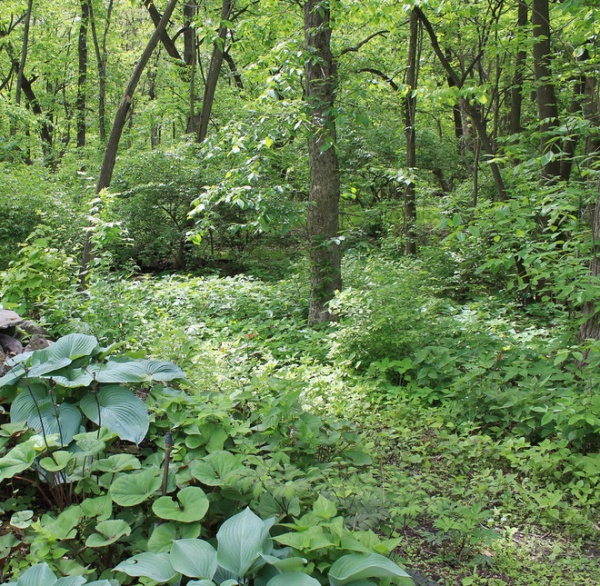
Pictured here is the unmanaged edge of a large estate property where the backyard garden meets an existing woodland. The client’s property line extends into the woodland several hundred feet. There are several things to observe in this photo: The garden plants in the foreground are in great shape and can be easily used on the site, the middle ground has a mix of desirable and undesirable plants — some natives, some weedy or invasive plants — and the background has a well-layered woodland of native trees and understory shrubs. The whole property has hundreds of existing plants, some of which should remain and others that should be transplanted or removed entirely. Determining what should remain and what should be removed begins with a plant inventory.
A plant inventory is created by working with an arborist and a land surveyor to understand the quantity and quality of existing vegetation. The landscape architect can shepherd the process and collaborate directly with the surveyor and arborist. Existing plants are surveyed for size, health and precise location and then added to a scaled drawing in digital format.
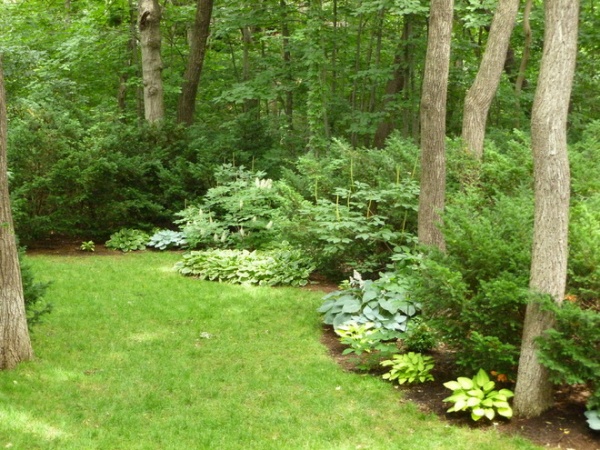
Getting Started
Find out the exact boundaries of your property. Know precisely where the property line is located, as staked and identified by a professional surveyor. You can’t move or remove anything outside of your property line or anything in a public right-of-way. This includes street trees, and sometimes trees along a utility easement or public drainage right-of-way. Check with your municipality prior to removing or clearing plants in these areas. This is particularly important for wet areas near ditches, swales or ponds, because there may be sensitive vegetation there that should not be removed.
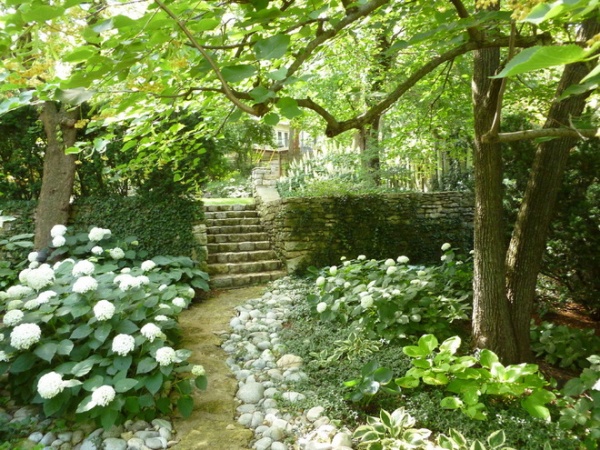
Consult a professional. Before beginning a major landscape project, it’s a good idea to have a surveyor create an updated boundary survey showing the property lines and rights-of-way. Additionally, the surveyor adds the precise locations of all of the trees and major shrubs to the survey document. The surveyor will create a precise digital drawing of your property that can be used by a landscape architect and an architect in the design of a new landscape and/or home. Surveyors create different types of surveys — like boundary surveys and topographic surveys. Note that the surveyor will mark the exact location of plants, but the species information needs to be filled in by a certified arborist or landscape architect.
Once the survey is complete, the landscape architect will identify existing shrubs, vines, grasses and ground covers and whether or not they are native, invasive or valuable, ornamental garden plants. The landscape architect will use all of this information as the basis for a plant inventory of existing species and to recommend which plants should stay, go or be reused. These decisions will be made in close consultation with the client.
For sites with many different trees, a certified arborist should be consulted to determine the health, approximate age and exact species of trees present. An arborist will also be able to identify any trees showing early signs of major disease and recommend a plan of action for treatment or removal. Unfortunately, fatal tree diseases are a reality, and it’s important to pinpoint and diagnose unhealthy trees as early as possible to prevent the spread of diseases.
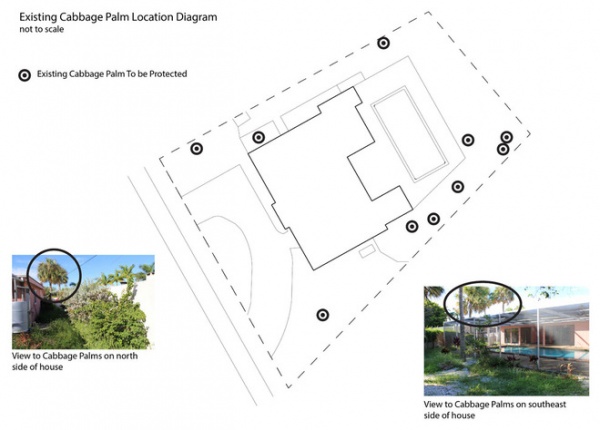
What Should Stay?
Pictured here is a diagram of the locations of existing cabbage palms to remain in a landscape design plan. The cabbage palms identified in the diagram are native, mature, healthy specimens that are to be kept in place and protected during the construction process. The vacation home and landscape for this project are undergoing a major renovation, and it’s important to clearly identify the plants to remain early in the design process. Even on small sites like this one, there is a significant cost savings to preserve existing plants appropriately instead of ripping everything out and starting new.
Healthy, noninvasive trees are the most important plants to keep. There are two primary reasons for preserving healthy, mature trees: First, they provide significant environmental services by cleaning the air, creating a shaded microclimate and providing habitat for wildlife. In fact, some animals rely exclusively on the habitat provided by mature trees. The second reason is that trees take decades to reach maturity, and their wide canopy takes a long time to replace. Neighborhoods and homes with healthy, mature trees typically have increased property values compared to similar homes without mature trees.
In addition, keep noninvasive, mature shrubs and valuable, ornamental plants in good condition. Perhaps you inherited some expensive garden plants from the previous property owner. They can be moved or cut back to be integrated into a new landscape design.
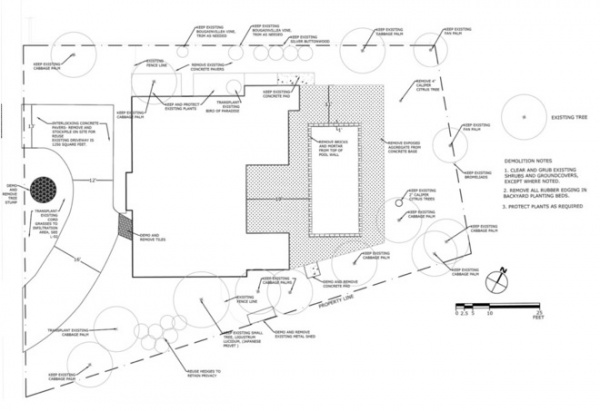
What Should Be Removed?
Plants identified for removal are the basis for a demolition plan by the landscape architect. Demolition plans include details about plants and hardscape to be removed in the first phase of landscape construction. The demolition plan pictured here identifies plants that should stay and be protected as well as old tree stumps and existing concrete to be cleared. The remaining plants are not individually identified but noted to be “cleared and grubbed,” a term for mechanical removal of plants.
Remove exotic, invasive species first. Disturbed sites and landscapes that have not been maintained as gardens may be running amok with invasive plants. It’s a top priority to get rid of these invasive plants in the rehabilitation of a landscape. Removal methods include mechanical removal or herbicide treatment. Mechanical removal (by hand or machine) is preferred because herbicides have a way of ending up in our groundwater. Removing invasives without herbicides usually takes longer and should be integrated into a phased landscape design to ensure that invasive plants are eradicated and do not reappear later.
It’s useful for the landscape contractor to know the extent of plants to be removed, because the demolition plan helps the contractor create an accurate bid for the work required for removal.
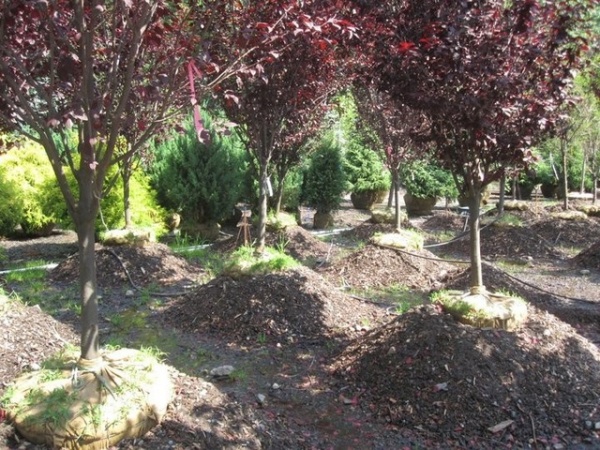
What Can Be Transplanted Elsewhere on the Site?
Small, healthy trees and shrubs of many sizes can be transplanted elsewhere with ease. Many people are surprised to learn that even large, mature shrubs can be transplanted as long as they are sufficiently prepped for moving and are in good health. Pictured here is a group of small trees being “heeled in” at a nursery. Heeling-in is a process that involves digging up plants to be moved and surrounding their roots with heavy mulch and irrigation while they are being held for future transplanting. This same process is done temporarily onsite for the phasing of large landscape construction projects.
The root structure of the plant species is another factor to consider when thinking about transplanting. Plants with a taproot can be the most difficult to move (some say impossible to move if the plant is mature), because the taproot extends deep into the soil and will not reestablish once it is moved.
Not all transplanted specimens will survive, even under ideal conditions, and it’s typical for some loss to occur. Oftentimes existing unmanaged plants have grown spindly or weedy and do not have a strong form. This is the case with many overgrown shrubs that have grown too close together and are competing for light and nutrients. Depending on the species, it’s not always worthwhile to reuse the shrub. Reuse or removal is determined on a case-by-case basis.
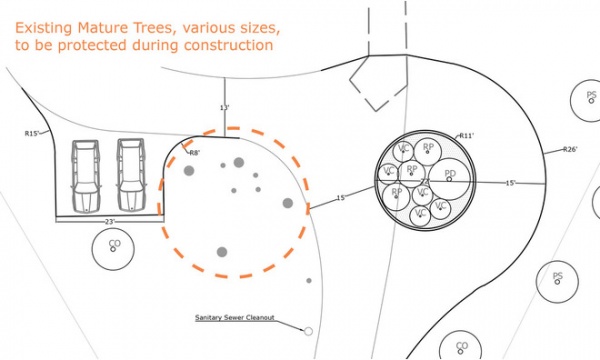
Pictured here is a snapshot of a new driveway layout and entry court for a landscape with many different sizes of existing native trees. The tree DBH (diameter of the trunk at breast height) was measured and the locations were georeferenced into a digital survey to design permeable driveway and vehicle access around the existing trees with minimal root interference.
Driveways, paved walkways and patios must be planned and designed with precision so that existing vegetation is not damaged during construction. In addition, the plant inventory is heavily referenced in the design of gardens to determine the proper spacing and size of new plants based on the space available under and around existing trees and shrubs. In this way the plant inventory provides an existing framework for a full landscape design plan.
Find more guides and inspiration in the Houzz Landscape Design section












